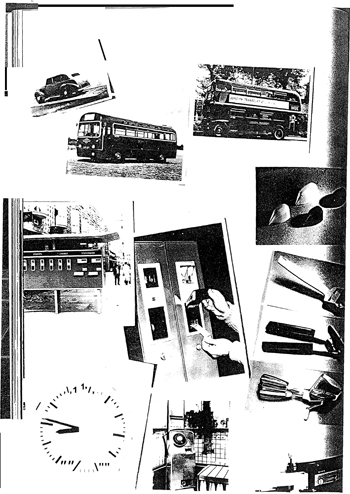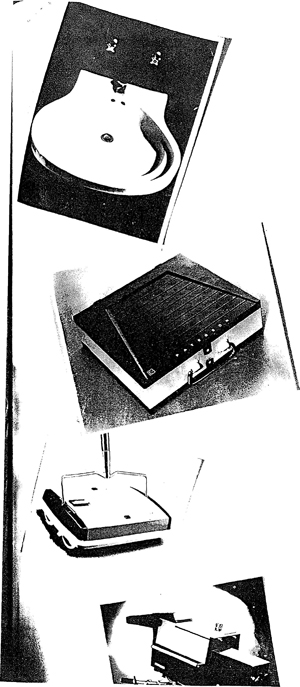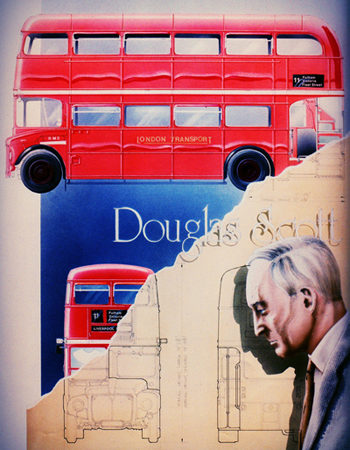ROUTE MASTER
 First published in Design, October 1983
First published in Design, October 1983Douglas Scott is the unsung hero of British industrial design. Largely unacclaimed, he designed products as universal as Aga cookers, the London double-decker bus and telephone coin boxes
Douglas Scott is smallish, nimble and sharp-eyed. He feels that the design establishment had something against him. That might be overstating it, but he has certainly not received the critical attention he deserves. Scott gets only a couple of plates in Fiona MacCarthy’s All Things Bright and Beautiful and none at all in Stephen Bayley’s In Good Shape. He may be too modest to think of it, but his work is long overdue a celebration.

Largely familiar objects show Scott’s impact on the designed environment. 1942 model for the Hillman Minx, RF single-decker and Routemaster double-decker, GPO stamp dispensers, telephone coin box and directory holder, and clock; also, early moulded plastics control knobs, and kitchen implements for Prestige
The son of an electrician, Scott trained as a silversmith and jeweller at London’s Central School of Art and Design in the late 1920s, when, he beams, ‘The Centralwas so renowned that countries like Egypt and India used to insist that their design students went there’. Following a six-year spell as a light fitting designer and illumination engineer with Osler & Faraday, the lighting group, he joined Raymond Loewy’s London office in 1936. After that he never looked back.
‘It was much harder to get a job in the Slump than it is now – nobody had any idea what an industrial designer was, and Loewy’s operation was the first ever industrial design consultancy on British soil. Sigmund Gestetner set him up in Aldwych House and every member of staff had to learn how to fake his signature on their drawings’. So it was that the Aga cooker (1938), which Scott redesigned for the English market, is officially Loewy’s work.
While architects such as Wells Coates and Serge Chermayeff turned their hands to consumer products, Scott had the distinction of being one of Britain’s first industrial designers as such. By World War Two he was in charge of Loewy’s London office and found himself working on bathware for Allied Ironfounders, fridges and cookers for GEC, and eighth-scale models of what was, after the war, to become the Rootes Group’s Hillman Minx.
At Loewy there were no clocks, because each job was supposed to take as long as it took. Architectural journalists attacked the consultancy’s radios for looking too much like cars (hardly surprising, as most of Scott’s senior colleagues had backgrounds with General Motors), but here Scott learned to design for the market.
‘We researched Dick Russell’s radio for Murphy to find out exactly why it was so popular,’ he recalls. ‘We imagined that there would be all kinds of complicated reasons, but in fact the answer was quite simple: the radio sold because its no-nonsense wooden cabinet was so plain that people thought more money had been spent on the guts than in models made by Philips or EMI’.
Scott has always eschewed pretentious gestures in design, preferring integrity and harmony in form to stylistic excess. Thus he readily asserts that Memphis has raised some important questions about the way products relate to people’s emotional needs, but admits to no great liking for the movement’s answers.
Shortly before the war, Scott came up with Britain’s first purpose-built urban street light. Like much of the designer’s subsequent work, it is still in use in odd parts of the world. Scott says he has seen one or two adorning roadsides in Cyprus, in the same way as he chanced upon one of his STD coin boxes (1955) in Normandy and one of his stamp dispensing machines (late 1950s) in Belgium. The war years, however, were no time for exports such as these; Scott passed them checking aero engines in the state-organised Aircraft Inspection Department. It was only after 1946, when he established his own design office, that he once more began to have a major, if understated, impact on national and international environments.

Ideal Standard basin, Paterson slide holder box, Ewbank floor sweeper for Prestige, and Marconi Mark 7 colour television camera
The range of Scott’s work from the late 1940s on is astonishing. In 1946 he founded the Central School’s industrial design course and on it taught students such as David Ogle and Martyn Rowlands, who went on to become leading design figures. He designed and colour-coordinated the exterior and interior of the RF single-decker Green Line bus (1948) for London Transport (LT) in three different versions. He did the LT Routemaster double-decker from bonnet configuration to passenger seat upholstery (1953). He was responsible for truck cabs for AEC (1963) and excavators for Hy-Mac (1965).
Nor were Scott’s most notable achievements as a design practitioner confined to transport. Apart from becoming the first consultant ever to be hired by the GPO (Britain’s post and telecommunications service), his marine radios and telephones for (USA) formed the basis of that company’s first in-house manual on industrial design, while his sanitaryware for Ideal Standard, Milan, was so elegant that the firm featured his name alongside those of Gio Ponti and Aehille Castiglione in its advertisements. His washbasin for Ideal, which was brought out in 1959 and is still in production, is on permanent exhibition in New York’s Museum of Modem Art. He is proud of being the first British designer on permanent exhibit there.
Despite his retiring nature, Scott could not but gain some recognition for all this. He won three Design Council awards and became a Royal Designer for Industry in 1974. But, significantly, he has had his most rapturous reception overseas. Scott trained the designers from Mexico University who established industrial design as a discipline in that country; as a result he is persona grata in three universities and much of industry there.
In many ways Scott’s career is the story of the first wave of British industrial design. In 1960, Scott established Allied Industrial Designers (as it was then known) with James Pilditch, and he worked with the consultancy until 1964. In his time he has designed exhibitions for Energen crispbread, computers for English Electric, and television and broadcasting equipment for Marconi. But his brilliance has yet to be publicised in the colour supplements; he remains, for most young students of industrial design (a constituency he has always had time for), an unknown figure.
Britain is likely to appreciate Scott too late – and the fault is Britain’s. What Scott says, as an aside and with a wry grin, about the Routemaster assignment confirms this all too clearly: ‘Since Britain was still in reconstruction, everything was pretty bureaucratic. London Transport therefore had no established procedures for dealing with consultant designers, who in those days were still regarded as rather strange people. So, as it turned out, I shall never forget how I got paid for the Routemaster job. The money came from petty cash’.
I tell you these COMMUNISTS are everywhere .
Er... China’s race to the moon to take private sector robots on Chang’e-8 mission
https://www.scmp.com/news/china/science/article/3296324/change-8-moon-mission-first-get-robotic-boost-chinas-private-sector?share=EN4%2BL4ZaGslezQXZBBDZEr1gs99Ko70v4a6kkRcfpshbjYVSb4v4IHuqxfqXTPyDE9QFZ5r8cYMuWwdT2t34h7ARZah8SH6Zw9YAWPFRuRO0dxXbnqLJWYRf0wjK4R2AvhKSBC09Ikdm%2BXtxSMdkTg%3D%3D&utm_campaign=social_share
Articles grouped by Tag
Bookmarks
Innovators I like

Robert Furchgott – discovered that nitric oxide transmits signals within the human body

Barry Marshall – showed that the bacterium Helicobacter pylori is the cause of most peptic ulcers, reversing decades of medical doctrine holding that ulcers were caused by stress, spicy foods, and too much acid

N Joseph Woodland – co-inventor of the barcode

Jocelyn Bell Burnell – she discovered the first radio pulsars

John Tyndall – the man who worked out why the sky was blue

Rosalind Franklin co-discovered the structure of DNA, with Crick and Watson

Rosalyn Sussman Yallow – development of radioimmunoassay (RIA), a method of quantifying minute amounts of biological substances in the body

Jonas Salk – discovery and development of the first successful polio vaccine

John Waterlow – discovered that lack of body potassium causes altitude sickness. First experiment: on himself

Werner Forssmann – the first man to insert a catheter into a human heart: his own

Bruce Bayer – scientist with Kodak whose invention of a colour filter array enabled digital imaging sensors to capture colour

Yuri Gagarin – first man in space. My piece of fandom: http://www.spiked-online.com/newsite/article/10421

Sir Godfrey Hounsfield – inventor, with Robert Ledley, of the CAT scanner

Martin Cooper – inventor of the mobile phone

George Devol – 'father of robotics’ who helped to revolutionise carmaking

Thomas Tuohy – Windscale manager who doused the flames of the 1957 fire

Eugene Polley – TV remote controls



0 comments